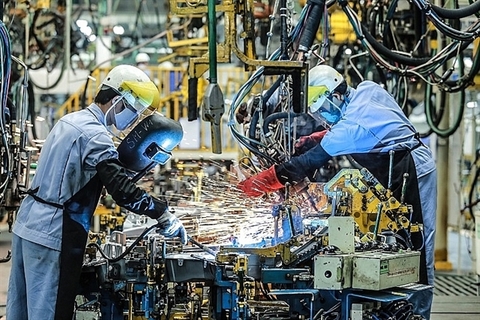
IIP in the first four months of 2023 decreased by 1.8 per cent on year. — Photo congthuong.vn
The index of industrial production (IIP) in April was estimated to increase by 3.6 per cent on month and by 0.5 per cent over the same period last year, according to the General Statistics Office (GSO).
However, the office also reported that IIP in the first four months of 2023 decreased by 1.8 per cent on year. The IIP growth in the first four months of 2022 was 7.8 per cent.
Among the sectors, the water supply, waste-water treatment and management activities recorded the highest IIP increase of 5.5 per cent in the first four months. The electricity generation and distribution sector followed with 0.5 per cent.
However, the mining industry and the processing and manufacturing saw a decline of 2.8 per cent and 2.1 per cent in IIP, respectively.
The world economy's slow recovery and tightened monetary policy in many countries has made the consumption demand of major trading partners decline, leading to a decrease in goods orders and export turnover. Those factors affected the growth of industrial production in the first four months of 2023, according to the Ministry of Industry and Trade (MoIT).
In terms of localities, the GSO said in the first four months, 52 localities gained growth in this index compared to the same period of last year, while IIP decreased in the remaining 11 localities.
Of which, Tuyen Quang recorded the highest increase in IIP at 14.8 per cent. Dak Lak followed with the IIP growth at 14.2 per cent. Other top ten localities achieving high growth rates included Thai Binh (13.8 per cent), Hau Giang (13.8 per cent), Hai Phong (13.4 per cent), Bac Giang (13.3 per cent), Quang Tri (12.2 per cent), Nam Dinh (12 per cent), Kien Giang (11.6 per cent), and Cao Bang (11.2 per cent).
Several essential industrial products showed a decrease in IIP during the first four months of 2023, including automobiles (19.3 per cent), bar and angle steel (15.1 per cent), mobile phones (13 per cent), motorbikes (12.3 per cent), urea fertiliser (12.2 per cent), textiles from natural fibres (11.1 per cent), casual wear (10.4 per cent), and phone components (10.1 per cent).
Meanwhile, some other products gained growth in IIP in the same period, such as sugar (23.2 per cent), gasoline (15.1 per cent), garments made from man-made fibres (12.2 per cent), NPK fertiliser (10.4 per cent), and chemical paint (6.1 per cent).
The world economy has shown signs of recovery but it is slow and unequal in different countries, so consumer demand is also recovering slowly. China's reopening also increases competition for Viet Nam's products in export markets.
They are factors that will continuously affect Viet Nam's production and trade activities in the coming months.
Besides that, the slow recovery of the real estate market and low disbursement of investment capital will affect the consumption of some related manufacturing industries.
To promote production development and support businesses, MoIT has said it will closely monitor the production of sectors and fields to promptly grasp and remove difficulties in promoting production development.
In addition, the ministry will continue to implement the connection of domestic enterprises to FDI enterprises and large global enterprises to participate in their global supply chains.
At the same time, it continues to support businesses, especially small and medium-sized enterprises, to recover and develop production through solutions for stabilising financial and monetary markets. Those solutions include proposing the exemption and reduction of some taxes and fees, and favourable conditions on access to credit.
According to experts, Viet Nam should give priority to the development of domestic manufacturing industries, especially the mechanical industry.
According to Nguyen Ngoc Thanh, deputy director of MoIT's Department of Industry, the processing and manufacturing industry plays a key role, creating the largest added value for the industrial sector. Most of Viet Nam's important economic sectors directly or indirectly depend on the manufacturing industry. It is also to provide employment and stable income for the long term.
So it is necessary to have timely and efficient policies and solutions to find markets for industrial products, thereby promoting domestic production and improving economic growth.
Assoc. Prof. Dr. Nguyen Chi Sang, vice chairman of the Viet Nam Association of Mechanical Industry, said that the Government should promote the development of finished mechanical products and large mechanical products for several industries such as wind power, high-speed railways and medical equipment. Viet Nam needed a strategy and a roadmap to make those products.
Economist Dr. Le Dang Doanh said it was necessary to promote Viet Nam's advantages for sustainable industrial development. Specifically, industrialisation in Viet Nam should combine agriculture and industry with the development of industrial products for lines processing agricultural products to enhance the value of Viet Nam's farm produce.
According to Thanh, to promote domestic production, the steel and mechanical industries need to take advantage of public investment capital in large projects in the field of industrial construction, infrastructure, transport and energy, to create a market for mechanical products.
For the auto industry, it is necessary to increase purchasing power to restore the auto market, maintaining and promoting the assembly of automobiles in the country.
MoIT is working with the Ministry of Finance to research and propose the Government issue a number of financial support policies for the industry. They include extending the deadline for paying excise tax or having incentives on registration fees for domestically manufactured and assembled cars. — VNS